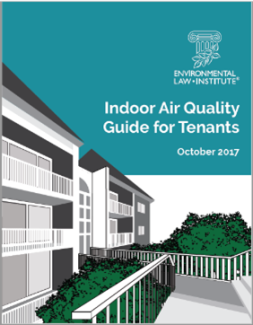
Indoor air quality is an important part of a healthy home. Exposure to indoor pollutants – from lead-based paint and radon to mold and secondhand smoke – can affect your health. Children, older adults, and people with asthma and other medical conditions may be especially vulnerable to the harmful effects of indoor air pollutants.
The Indoor Air Quality Guide for Tenants offers a starting point for learning more about indoor air quality (IAQ) in the home. It describes common IAQ problems, explains what laws might apply to IAQ conditions in rental properties, and suggests where to look for more information and for assistance resolving IAQ problems.
This guide does not provide legal advice and is not a substitute for consulting a lawyer about your own situation. The guide does not describe the specific laws of each state or community but it explains how to find out about state and local laws where you live.
Overview of the Guide
The guide is organized into five main parts and three appendices.
PART 1: Learning About Common IAQ Problems. There are many conditions and activities in a home that can affect indoor air quality. This section describes several common IAQ problems – mold/dampness, secondhand smoke, lead-based paint, pests/pesticides, radon, and inadequate ventilation.
PART 2: Preventing and Fixing IAQ Problems. There are steps you can take to maintain a healthy home. Preventing and fixing some IAQ problems will usually require action by the landlord. It is important that IAQ repairs are made promptly and correctly to reduce health risks and property damage. This section describes government agencies and other offices in a state or local community that might have information about how to prevent and fix IAQ problems.
PART 3: Understanding the Types of Laws that Address IAQ in Rental Housing. State and local laws establish general health and safety standards for rental housing. Some laws might address specific IAQ conditions. The laws are different for each state and local community. This section describes three main types of state and local laws that are most likely to address IAQ in rental homes: housing codes, landlord-tenant laws, and laws on specific issues (such as smoking). This part also describes federal laws that prohibit housing discrimination on the basis of disability. Keep in mind that some of the laws described in the guide may have changed after the guide was published in 2017.
PART 4: Finding Information About the State and Local Laws Where You Live. Because IAQ and rental housing laws are different from one state or local community to another, it is important to learn about the laws where you live. This section describes how to find written materials that explain what your state and local laws say about tenants’ legal rights and responsibilities. It also explains how to find your laws online.
PART 5: Resolving Disputes About IAQ Problems. If you are not able to work with your landlord to fix an IAQ problem, there may be a government agency that can help. You may also have private legal remedies if the landlord does not maintain the property or make repairs as the law requires. This section describes the local housing code enforcement process and provides information on some possible sources of legal assistance.
APPENDIX A: State Laws on IAQ in Rental Housing: Overview and Examples - gives a more detailed explanation and examples of how some state laws address specific IAQ problems in rental housing.
APPENDIX B: Additional Housing Standards for Federally-Assisted Housing - describes federal regulations that establish property maintenance standards for federally-assisted housing.
APPENDIX C: State and Local Model Programs for Addressing IAQ in Rental Housing - describes model programs for (1) improving the housing code inspection process and (2) providing legal assistance for tenants in housing court.
Explore other materials from ELI’s Indoor Environments Program.
© Environmental Law Institute®